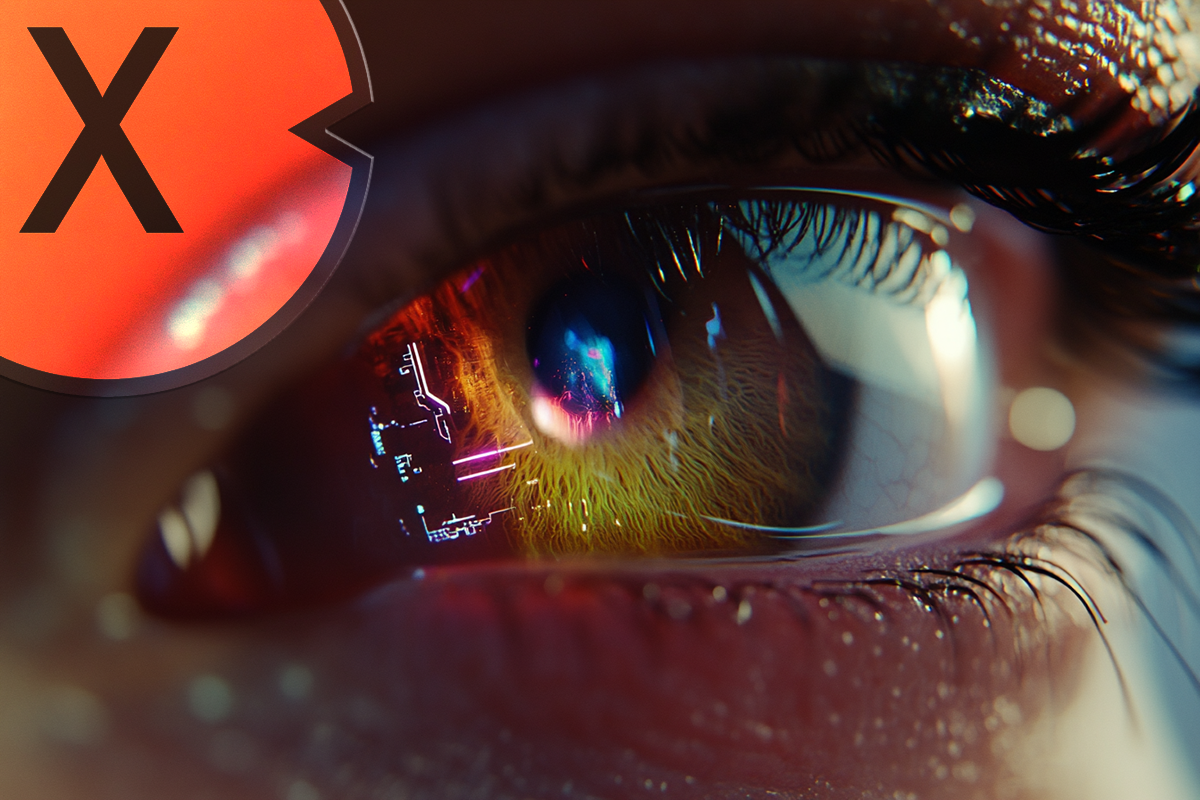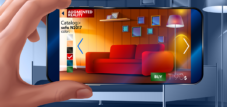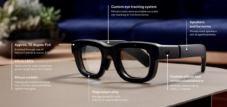The development of intelligent contact lenses: Augmented Reality (AR) with Extended Computing (XC) – Mojo Vision – Xpanceo – Inwith
Language selection 📢
Published on: November 7th, 2024 / Update from: November 7th, 2024 - Author: Konrad Wolfenstein

The development of intelligent contact lenses: Augmented Reality (AR) with Extended Computing (XC) – Image: Xpert.Digital
👁️ The future of vision: Intelligent contact lenses – more than just vision correction
🚀💡 Smart contact lenses are no longer science fiction, but a rapidly developing technology that has the potential to fundamentally change our everyday lives. They go far beyond conventional vision correction and combine advanced electronics, miniaturization and sensors in an inconspicuous format. From augmented reality (AR) to medical applications to performance optimization in sports – the possibilities seem limitless.
🔍 A look into augmented reality: AR and VR through intelligent contact lenses
The most well-known application of intelligent contact lenses is augmented reality. Companies like Mojo Vision are working on lenses that project virtual information directly into the wearer's field of vision. Imagine seeing navigation directions, news, or real-time translation right in front of your eyes without the need for a smartphone or bulky AR glasses. Micro-LED displays with extremely high pixel density, such as the 14,000 ppi targeted by Mojo Vision, are intended to provide razor-sharp images and enable an immersive experience. The technology could also be used in the field of virtual reality by completely blocking out the real world and replacing it with virtual environments.
🏥 Medicine at a glance: Continuous eye health monitoring
In addition to AR, smart contact lenses offer enormous potential in healthcare. They could become an unobtrusive yet powerful tool for continuous monitoring of important vital parameters. Sensors in the lens could, for example, measure the blood sugar level in tears, helping diabetics to constantly monitor their blood sugar levels without having to constantly prick themselves. Intraocular pressure, an important indicator of glaucoma, could also be continuously monitored. Other possible applications include measuring lactate levels in athletes or detecting early-stage eye diseases. This non-invasive form of data measurement could significantly improve patients' quality of life and facilitate the early detection of diseases.
🔎 See sharper: Improve vision with smart lenses
Intelligent contact lenses could also open up new perspectives for people with visual impairments. Using electronic image processing, they could increase contrast, sharpen edges and even enlarge text. This would help people with age-related macular degeneration (AMD), cataracts or other vision problems to see their surroundings more clearly and maintain their independence. The technology could also be used to correct vision defects such as nearsightedness or farsightedness, replacing conventional glasses or contact lenses.
🏃♂️ Top performance in focus: sport and performance optimization
Intelligent contact lenses also open up new possibilities in sports. Training data such as heart rate, speed or distance traveled could be projected directly into the field of view in real time without distracting the athlete from training. The technology could also be used to improve concentration and optimize movement sequences. For example, golfers could analyze their swing or runners could optimize their stride length.
🚧 Challenges on the way to the perfect lens
Despite the promising possibilities, developers of smart contact lenses still face several challenges:
power supply
The miniaturization of electronics requires powerful and long-lasting energy sources. Miniaturized batteries or innovative solutions such as generating energy through eye movements are in demand here.
Miniaturization and comfort
Integrating electronics, sensors and displays into a soft, flexible contact lens is a complex task. Wearing comfort should not be neglected. The lens must be comfortable to wear for long periods of time without irritating or damaging the eye.
Data transfer
The collected data must be transmitted reliably and in real time to external devices such as smartphones or computers. Efficient and energy-saving wireless communication technologies are essential for this.
Hygiene and safety
Since the lenses are worn directly on the eye, the highest hygienic standards must be maintained. The materials must be biocompatible and minimize any increased risk of infection or irritation. Data security also plays an important role. Sensitive health data must be protected from unauthorized access.
🔮 A look into the future: When will smart contact lenses become a reality?
Companies like Mojo Vision and Inwith work hard to develop and perfect their prototypes. Clinical studies are already underway and the first products could come onto the market in the next few years. It is expected that intelligent contact lenses will initially be used in the medical sector and in specialized applications such as sports. In the long term, however, they could become an everyday companion and revolutionize the way we interact with the digital world. The future of vision has just begun.
📣 Similar topics
- 👓 The future of vision: Smart contact lenses and their applications
- 📱 Advanced technology on the eye: intelligent lenses in everyday life
- 💡 Revolution in augmented reality: intelligent contact lenses in use
- 🩺 Health monitoring rethought: Intelligent lenses in medicine
- 🔍 Innovative vision improvement: Electronic support through contact lenses
- 🏃♂️ Improving performance in sports: Intelligent lenses for athletes
- 🔋 Overcoming challenges: Powering smart lenses
- ⚙️ High-tech miniaturization: Smart lenses and comfort
- 📡 Data transmission in focus: communication technologies for intelligent lenses
- 🔒 Safety and hygiene: standards for the use of smart contact lenses
#️⃣ Hashtags: #SmartContactLenses #AugmentedReality #HealthMonitoring #SportsTechnology #FutureTechnology
🗒️ Xpert.Digital: A pioneer in the field of extended and augmented reality
🌟 Smart Contact Lenses: A revolution in technology
🚀🕶️ Smart contact lenses represent a revolutionary technological innovation that has the potential to fundamentally change everyday life. While traditional contact lenses only serve to correct vision, this new generation goes far beyond that. The integration of advanced electronics and sensors into the structure of the lens creates completely new possible applications, ranging from augmented reality (AR) to medical monitoring to improving performance in sports. Companies like Mojo Vision and Xpanceo are at the forefront of this exciting development and are driving research and prototype development to bring this vision to market.
🌟 Functionalities and applications of smart contact lenses
1. 🌟 Augmented Reality (AR) and Virtual Reality (VR)
One of the most fascinating applications of smart contact lenses is in the area of augmented reality (AR). While today's AR applications rely on devices such as smartphones or special glasses, smart contact lenses could project virtual information directly into the user's field of vision. This is made possible by extremely small micro-LED displays that achieve a pixel density of up to 14,000 ppi to deliver crisp images.
Such lenses could allow users to integrate information such as directions, messages, notifications or even entertainment content into their natural vision - all without having to wear additional devices. “Smart contact lenses enable users to see and interact with content in a natural way,” is the manufacturer’s stated goal. Such applications could be particularly advantageous in a professional context or in education. For example, medical staff could read patient data in real time without having to look at a screen, or architects could see their blueprints projected right in front of them.
2. 🌟Medical monitoring and healthcare applications
In addition to the impressive AR features, smart contact lenses also offer promising opportunities for health monitoring. They are particularly important for chronically ill people, especially diabetics and people with glaucoma. Sensors in the lens could continuously measure physiological parameters such as blood sugar levels or intraocular pressure by analyzing the composition of tear fluid. This method is non-invasive and therefore a much more comfortable alternative to conventional, invasive procedures, which are often uncomfortable or painful.
With the ability to monitor data in real time and send an immediate alert in the event of abnormalities, smart contact lenses could make life easier and better for many patients. In this way, diabetics could be warned about dangerous blood sugar imbalances before they occur. In the future, these lenses could monitor other vital parameters and thus become an important part of personal health management.
3. 🌟 Vision improvement for people with visual impairments
In addition to monitoring health metrics, smart contact lenses also provide support for people with visual impairments. People suffering from diseases such as age-related macular degeneration (AMD) or other vision problems could improve their vision electronically with such lenses. These lenses would be able to enhance contrasts, sharpen edges and even enlarge text, which could make everyday life much easier for those affected.
The integration of such functions could also provide significant help for older people who suffer from declining eyesight and are therefore limited in their independence. The future of contact lenses goes far beyond vision correction – it could play a crucial role in optical rehabilitation.
4. 🌟 Performance optimization in sports
Smart contact lens technology could also play an important role in the field of sports. Athletes could have real-time information about their physical performance and progress displayed directly in their field of vision. This includes data such as heart rate, running speed, calorie consumption and more.
Smart contact lenses could also help optimize concentration and focus by giving athletes targeted advice on breathing or posture. This could provide a competitive advantage, especially in professional sports, and help to achieve one's full performance potential. This type of personalized and unobtrusive support could become a crucial part of professional training in the future.
🌟 Technological challenges and obstacles
Although progress in the development of smart contact lenses is impressive, researchers and developers face a variety of technical challenges that must be resolved before the lenses can be commercialized widely. The biggest challenges include:
power supply
The lenses require a sufficient power source to operate the integrated functions for extended periods of time without the need for frequent recharging. Some prototypes experiment with miniaturized batteries or alternative energy generation methods, such as B. the use of energy generated by eye movements. A major breakthrough in this field could make the use of such lenses much easier.
Miniaturization and comfort
Integrating complex electronics into the very limited surface area of a contact lens is a significant challenge. Companies like Mojo Vision are therefore relying on scleral lenses that are larger than traditional contact lenses and offer more space for electronics. Other manufacturers, such as the company Inwith, are trying to integrate flexible microelectronics into soft contact lenses to improve wearing comfort. However, the challenge is balancing functionality and comfort without compromising the safety of the lenses.
Hygiene and safety
Because contact lenses are worn directly on the eye, there is an increased risk of infection and irritation. Deposits of proteins and fats on the lens can cause problems. Therefore, it is essential to use materials that are safe and suitable for long-term contact with the eye. Manufacturers must ensure that the lenses can be safely worn for long periods of time without increasing the risk of infections or other side effects.
🌟 Future developments and social implications
The rapid development of this technology suggests that smart contact lenses could be ready for the market in the near future. Companies like Mojo Vision and Xpanceo are hard at work refining their prototypes and planning clinical trials and market launches by 2026. The implications of widespread adoption of smart contact lenses are far-reaching and affect both individual and societal levels.
The possible applications go far beyond individual use: intelligent contact lenses could also be useful in emergency situations, for example for quick initial medical diagnosis or to support rescue workers. They could also become an important tool in modern communication by providing an overview of information while maintaining privacy. These lenses, similar to smartphones, could radically change the way we interact with information and the environment and even help reduce dependencies on other mobile devices.
But these possibilities also come with ethical and data protection questions. The permanent data transfer, which is necessary for many applications, could pose data protection risks. It is therefore necessary to create a legal framework to make the use of such technologies safe and transparent. Protecting privacy and ensuring voluntary use must be a top priority when introducing smart contact lenses in order to gain user trust and prevent potential abuse.
🌟 Development of smart contact lenses
The development of intelligent contact lenses shows how far the miniaturization of electronics and sensors has already progressed and what potential lies in the fusion of technology and biology. Applications range from practical augmented reality functions to life-changing possibilities in medicine and the everyday lives of people with visual impairments. Even though the technology is still in its infancy and technical and ethical questions need to be clarified, developments in recent years clearly show that the vision of intelligent contact lenses could soon become a reality.
📣 Similar topics
- 🔍 Revolutionary technology: Intelligent contact lenses
- 👀 Future of vision: From AR to health monitoring
- 🏥 Medical innovations: contact lenses of the future
- 📈 Improving performance in sports through smart lenses
- ⚠️ Technological challenges and solutions
- 💡 Intelligent electronics: The miniaturization of the future
- 🔬 Health management with smart lenses
- 🌟 Augmented Reality: Reality redefined through contact lenses
- 🏃♀️ Sports and technology combined: The role of intelligent lenses
- 🔒 Data protection and ethics in smart contact lenses
#️⃣ Hashtags: #IntelligentLenses #AugmentedReality #HealthMonitoring #TechnologicalInnovation #PrivacyEthics
We are there for you - advice - planning - implementation - project management
Industry Hub Blog
An industry hub blog is a digital platform where content related to specific industries, sectors or business areas is published. The term "hub" refers to a central location or hub where relevant information, news, insights and resources are made available to professionals, entrepreneurs, investors and those interested in a particular industry. An Industry Hub Blog serves as an information source and discussion forum designed to connect the community, share knowledge and follow the latest developments in the respective industry.
I would be happy to serve as your personal advisor.
You can contact me by filling out the contact form below or simply call me on +49 89 89 674 804 (Munich) .
I'm looking forward to our joint project.
Features of an Industry Hub Blog
Industry-specific content
An industry hub blog focuses on a specific industry or sector of the economy. The published content covers topics that are relevant to professionals and interested parties in this industry.
Latest news
The blog provides current news and updates on developments, trends, market events and events in the respective industry.
Expertise and insights
Industry Hub Blogs provide expertise, insights and analysis from experts and industry insiders. This information can help develop a deeper understanding of the challenges and opportunities in the industry.
Best practices and tips
The blog can provide best practices, advice and tips for companies and professionals in the industry. This can range from business strategies to technology trends.
Networking and community building
Readers often have the opportunity to leave comments and participate in discussions. This creates an online community of like-minded people who can share ideas and connect with each other.
Resources and tools
Industry Hub Blogs can provide links to useful resources, tools, guides and reports relevant to the industry.
Events and conferences
The blog can also provide information about upcoming industry events, conferences, trade shows and webinars.
Xpert.Digital - Konrad Wolfenstein
Xpert.Digital is a hub for industry with a focus on digitalization, mechanical engineering, logistics/intralogistics and photovoltaics.
With our 360° business development solution, we support well-known companies from new business to after sales.
Market intelligence, smarketing, marketing automation, content development, PR, mail campaigns, personalized social media and lead nurturing are part of our digital tools.
You can find out more at: www.xpert.digital - www.xpert.solar - www.xpert.plus
























